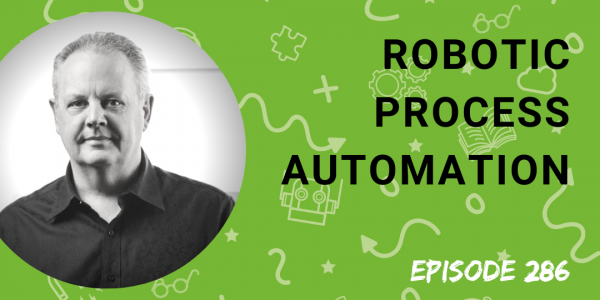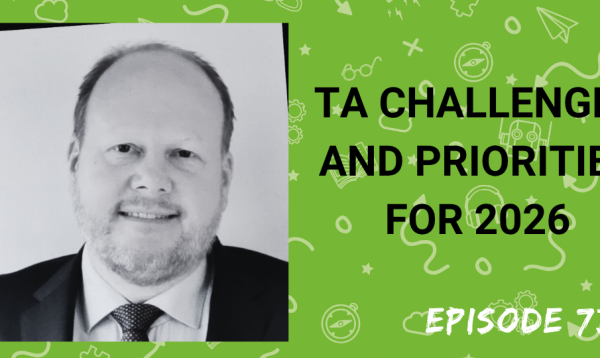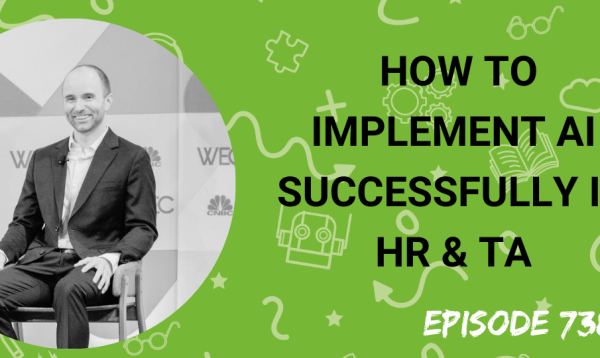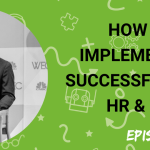The events of 2020 are accelerating recruiting automation at a pace none of us could have previously predicted. One of the problems with the current approaches to automation in talent acquisition is that things tend to be vendor lead, and finding a vendor who fully aligned to all of your needs can be a challenge.
In Episode 283, I discussed the importance of building a strategy for automation and having a helicopter view of all of the elements. However, it is only possible for TA Leaders to take that helicopter view if they have an understanding of the critical building blocks of automation.
My guest this week is Leigh Pullen, Co-Founder and CEO at CiGen a Robotic Process Automation services company based in Melbourne Australia. Robotic Process Automation or RPA as it is better known is something everyone in talent acquisition needs to understand.
In the interview, we discuss:
• What is Robotic Process Automation?
• Current HR use cases for RPA
• Combining RPA with Machine Learning, Natural Language Processing and Artificial Intelligence
• Humans vs Robots
• What will RPA make possible in the future
• The impact on jobs
Subscribe to this podcast in Apple Podcasts
Transcript:
Matt Alder [00:00:00]:
Support for this podcast is provided by Atrax. Atrax is the total career site system which converts site visitors into high quality job applicants. A fully SaaS system, Atrax is powered by the latest AI to deliver an outstanding and relevant talent experience, personalized employer branding and a strong conversion of candidates into the ATS. To find out more go to www.attra. that’s www. Attrax.co.uk and attracts is spelled a double T R A X.
Matt Alder [00:01:00]:
Hi everyone, this is Matt Alder. Welcome to episode 286 of the Recruiting Future podcast. The events of 2020 are accelerating recruiting automation at a pace none of us could have previously predicted. One of the problems with the current approaches to automation in talent acquisition is that things tend to very much be vendor led and finding a vendor who is fully aligned to all of your needs can be a challenge. In episode 283 I discussed the importance of building a strategy for automation and having a helicopter view of all the elements. However, it’s only possible for TA leaders to take that helicopter view if they have an understanding of the critical building blocks of automation. My guest this week is Leigh Pullen, Co founder and CEO at CiGen, a robotic process automation services company based in Melbourne, Australia. Robotic process Automation, or RPA as it’s better known, is something everyone in Talent Acquisition needs to understand and I know you’re going to find this interview really valuable.
Matt Alder [00:02:20]:
Hi Leigh and welcome to the podcast.
Leigh Pullen [00:02:22]:
Hi Matt, how are you? And thank you for having us on or having me on.
Matt Alder [00:02:25]:
I’m great, thank and an absolute pleasure to have you on the show. Could you just introduce yourself and tell everyone what you do?
Leigh Pullen [00:02:32]:
I’m Leigh Pullen, I’m the co founder and CEO of a RPA services company called CiGen in Melbourne, Australia. So we run services to help companies put RPA and the other technologies that go with it into service at all.
Leigh Pullen [00:02:51]:
Various types of companies.
Leigh Pullen [00:02:52]:
So keeps us very busy these days.
Matt Alder [00:02:54]:
It’s interesting because in the recruitment and.
Leigh Pullen [00:02:57]:
HR sector that I work in, we’ve only really just started to talk about.
Matt Alder [00:03:02]:
RPA and I don’t think that many people actually understand even what it stands for, what it is and what it does, even though they may be using it in some way.
Leigh Pullen [00:03:11]:
Already. Talk us through rpa. What is that?
Leigh Pullen [00:03:13]:
So rpa, the acronym stands for Robotic Process Automation. They’re not physical robots, they’re software robots. So there’s no cyborgs walking around or anything like that. Is software that emulates what a person does at their computer, but on a much faster, bigger scale and a much more accurate scale. So it can act like a person does, going into something like Excel or CRM or a HR application, ERP application.
Leigh Pullen [00:03:55]:
Taking information. It’s directed to take information from different.
Leigh Pullen [00:03:59]:
Areas and move and take that information.
Leigh Pullen [00:04:02]:
And maybe put it somewhere else.
Leigh Pullen [00:04:04]:
It can be, it can do calculations. It’s a very handy tool across every industry, across every business, and has favored to date. It started mainly in the finance office, if you like, you know, accounts payable in that area. But HR is very big also in.
Leigh Pullen [00:04:27]:
In robotic process automation.
Leigh Pullen [00:04:28]:
Tell us a little bit about the history.
Matt Alder [00:04:32]:
How long has it been in the, in the current form and how did it develop?
Leigh Pullen [00:04:36]:
Well, I’ll probably go backwards a little bit. Its history started off as desktop automation. So if you go back probably 10 years ago, there were small programs on desktop that could emulate and pick up.
Leigh Pullen [00:04:50]:
Little bits of data if you taught.
Leigh Pullen [00:04:51]:
It what to do and move things around on your desktop. But it couldn’t move off your desktop at that particular stage and it had limited functionality. About, oh, call it six, seven years ago, it started to build into robots that sat on servers and sat in what we call the back office and were controlled by some sort of orchestration piece of technology.
Leigh Pullen [00:05:22]:
Let’s just call that the control tower of the robots.
Leigh Pullen [00:05:25]:
And you began to create robotic workflows to instruct the robots what to do across different platforms, across an organization, but.
Leigh Pullen [00:05:37]:
They sat on servers.
Leigh Pullen [00:05:38]:
And then as it progressed, it became more and more a combination of back office robots that worked 24, seven in.
Leigh Pullen [00:05:48]:
The back on servers and front office.
Leigh Pullen [00:05:51]:
Robots that effectively a person had to push go. So think of contact center when you don’t know something has to start and.
Leigh Pullen [00:06:01]:
They push a button for the robot to do something.
Leigh Pullen [00:06:03]:
Which is a little bit more like desktop automation these days. It is joined by everything from you get into machine learning, natural language processing.
Leigh Pullen [00:06:15]:
AI, all of those sort of things.
Leigh Pullen [00:06:17]:
Amalgamate together to be part of what.
Leigh Pullen [00:06:19]:
We call the AI tree here at Cygen.
Leigh Pullen [00:06:21]:
But it’s a combination of different platforms.
Leigh Pullen [00:06:25]:
That all work together to build an.
Leigh Pullen [00:06:27]:
Outcome which we can go into in.
Leigh Pullen [00:06:29]:
A little bit of detail.
Matt Alder [00:06:30]:
Yeah, absolutely.
Leigh Pullen [00:06:30]:
That would be a really good thing to do now.
Matt Alder [00:06:32]:
I mean, could you sort of give us some examples of how it’s used or just kind of walk it through a little bit for us?
Leigh Pullen [00:06:38]:
Sure. So as an example, a common usage is to Companies will receive invoices from suppliers. They often go into a email account to a accounts payable email. The robots can pick up, read those emails, extract the invoice document and often they’re in PDF form read the contents on that PDF because robots have the ability to read OCR or read the text behind it, depending on which way you do it, extract that information and then use that information to update that detail one by one in an ERP system. So it would log on to the accounts payable, it could update that big piece of information. Take the invoice number, the invoice date, the company it’s from, the total amount, any taxes due, all line by line.
Leigh Pullen [00:07:35]:
Item and check it against purchase orders.
Leigh Pullen [00:07:37]:
And all of that sort of thing.
Leigh Pullen [00:07:39]:
That’s one use. Another use is extracting data out of.
Leigh Pullen [00:07:43]:
Salesforce, for example, as a CRM and.
Leigh Pullen [00:07:46]:
Moving that into another application such as again an ERP system because some sales have arisen from the Salesforce system. And then you would see something in hr.
Leigh Pullen [00:07:58]:
You will see and we’ve certainly done this type of work where companies have a lot of onboarding and off boarding of personnel. So the robots will come in, take.
Leigh Pullen [00:08:08]:
Extract all of the information out of.
Leigh Pullen [00:08:10]:
The documentation for that new employee. It would set that up in the.
Leigh Pullen [00:08:15]:
Account in the HR systems, the payroll.
Leigh Pullen [00:08:18]:
Systems go and can go further and switch on all of the IT access for that person given whatever that type of job is. And you see the reverse when someone’s leaving the company when what we call offboarding. So there’s, we’ve had, we, we’ve done pay runs with robotics from an HR point of view. So the types of tasks, as long as the tasks are structured, in other.
Leigh Pullen [00:08:46]:
Words, the process is structured. It’s not an unstructured process. As long as the process is structured.
Leigh Pullen [00:08:53]:
It has data that is either digital.
Leigh Pullen [00:08:56]:
Or the robot can turn into digital data. It can do something with it.
Matt Alder [00:09:00]:
That’s really interesting stuff. And it kind of brings on to my next question actually, which I was going to ask about the almost what the limits of possibility are around this. What could this do that humans currently.
Leigh Pullen [00:09:12]:
Do and what could it not do.
Matt Alder [00:09:14]:
If that makes sense. I mean, suppose particularly in the context of AI and machine learning and some of the other technologies that are developing at the moment.
Leigh Pullen [00:09:21]:
Sure. Well, it can do a lot of office tasks that people do that are fairly standard. As I was saying before, as long as the process is relatively structured, it can go ahead and do those type of tasks. An example would be we’ve had a, a Company that’s a facilities company, they.
Leigh Pullen [00:09:45]:
Buy lots of food for all of.
Leigh Pullen [00:09:47]:
These different mines and aged care around Australia. They get rebates from, they get rebates from the food companies. Depending on what they are per quarter, it would take them over a year, more than eight man months to work out what those rebates were. The robot does that in two hours and finds more money. As an example of going to the.
Leigh Pullen [00:10:11]:
Extreme of what robots can do. Robots are excellent at standard tasks.
Leigh Pullen [00:10:15]:
They in standard RPA form. What, what I mean robotic process without AI, without machine learning, without natural language. It can do about 40 to 60% of the standard tasks that are in a company. A robot as smart as an intelligent as they are, they are also obviously somewhat dumb.
Leigh Pullen [00:10:38]:
If you haven’t told a robot to go left or right at a T.
Leigh Pullen [00:10:41]:
Intersection, it will stop unless you in sigin we we would have an overlay.
Leigh Pullen [00:10:48]:
That would always allow the robot to exit gracefully.
Leigh Pullen [00:10:53]:
So there is a limitation on what it, what it can do. It can’t make up its own mind. But as you start to add machine learning, which is when you get into machine learning, it’s a recognition, we’d call.
Leigh Pullen [00:11:06]:
It a recognition system, a high level recognition system.
Leigh Pullen [00:11:10]:
It might have seen that type of error before and it knows how to handle it. So it keeps that online natural language. You can start reading the body of an email.
Leigh Pullen [00:11:20]:
Natural language gets into not just language.
Leigh Pullen [00:11:22]:
But syntax and is trying to defer meaning so that it can take it further. And an AI is largely complex or.
Leigh Pullen [00:11:34]:
Very fast algorithms to do things with.
Leigh Pullen [00:11:37]:
So typically robots, RPA would create or clean data for AI program to work or take the output from an AI.
Leigh Pullen [00:11:47]:
Program and do something with it.
Leigh Pullen [00:11:49]:
So if you think RPA is the.
Leigh Pullen [00:11:52]:
Practical doer of the group, the rest.
Leigh Pullen [00:11:54]:
Of them are recognition programs and high level instructions and calculators if you like.
Matt Alder [00:12:02]:
How does this get positioned in the market? And what I mean by that is I’ve spoken to a couple of software vendors in the, in the recruiting space.
Leigh Pullen [00:12:11]:
Who sell software solutions to, to employers and both of them are using RPA in the background with some of the integrations and things that they were doing. Is this something that people would buy baked, already baked into another bit of.
Matt Alder [00:12:25]:
Software or is it something that a.
Leigh Pullen [00:12:27]:
Company would buy as a standalone thing.
Matt Alder [00:12:30]:
To sort of tie together their own.
Leigh Pullen [00:12:32]:
Processes or separate bits of software that they have?
Leigh Pullen [00:12:35]:
Well, they’re both, they’re both available. So there is quite a few application provide, you know, software makers that are building some type of RPA into their product these days, but they are generally limited around where they can go. Whereas if you go to the broader main RPA engines, and here we’re talking UiPath, automation, anywhere, blue Prism and tools of those sort of nature, they have a much broader appeal and are not limited by not being able to read.
Leigh Pullen [00:13:11]:
Different types of software programs.
Leigh Pullen [00:13:13]:
I mean, at cygen we use UiPath and UiPath only. We to date over 5 years, have not found an application we could not automate. And we’re going everywhere from your most.
Leigh Pullen [00:13:26]:
Modern application web applications to green screen applications.
Leigh Pullen [00:13:31]:
And that’s the beauty of the broad tools.
Leigh Pullen [00:13:35]:
They can get across everything.
Leigh Pullen [00:13:37]:
And so there are cases for, in smaller software organizations like some of the accounting online that can do a little bit of robotics, but it’s nowhere near.
Leigh Pullen [00:13:47]:
As broad as the type of things that we would get involved in.
Leigh Pullen [00:13:50]:
Final question.
Matt Alder [00:13:51]:
So obviously this has developed a lot in the last few years and it sounds like, sounds like its abilities are.
Leigh Pullen [00:14:00]:
Kind of evolving all the time. What does the future look like?
Matt Alder [00:14:03]:
What’s going to be possible in, in.
Leigh Pullen [00:14:05]:
Three or four years time with this type of technology?
Leigh Pullen [00:14:08]:
Well, you’re going to see, you’re going to see machine learning, you’re going to see natural language and AI merge more and robotics merge in with those and utilize those technologies far more than we are today. Four years ago it was purely rpa.
Leigh Pullen [00:14:29]:
Two years ago we were starting to.
Leigh Pullen [00:14:31]:
Play with machine learning.
Leigh Pullen [00:14:32]:
Today we use machine learning, machine learning.
Leigh Pullen [00:14:35]:
For example, if you take an invoice.
Leigh Pullen [00:14:39]:
It begins to recognize the placement of.
Leigh Pullen [00:14:42]:
Where, where sections are on an invoice.
Leigh Pullen [00:14:45]:
It begins to recognize words. For example, in an invoice.
Leigh Pullen [00:14:52]:
The word invoice, the word you’ll get an INV number, invoice number, bill number, contract, they all mean the same thing.
Leigh Pullen [00:15:01]:
But rather than have to program it.
Leigh Pullen [00:15:03]:
Four different ways, machine learning recognizes each one of those can be the same as long as I train it in.
Leigh Pullen [00:15:11]:
Either a supervised or an unsupervised way.
Leigh Pullen [00:15:13]:
Meaning it’s got to build up a body of knowledge and recognize it. So as we use more of these tools, when I said earlier that RPA.
Leigh Pullen [00:15:25]:
By itself can do 40 to 60% of standard processes, we’re now starting to.
Leigh Pullen [00:15:30]:
Get into 60, 80 and maybe even.
Leigh Pullen [00:15:32]:
90% of standard processes that can be.
Leigh Pullen [00:15:35]:
Utilized with the other tools that add on. So it becomes a much richer format and much richer capability, which then really leaves people. And the reasons you put RPA in is that you’re looking for process cost.
Leigh Pullen [00:15:52]:
Reduction, of course, you’re looking for quality.
Leigh Pullen [00:15:55]:
Improvements and A big one is headcount flexibility to release headcount from the mundane.
Leigh Pullen [00:16:02]:
Areas so that I can use it for something else in the business, which is largely what’s been done today. You’re looking for revenue leakage.
Leigh Pullen [00:16:10]:
How can robotics and the other tools find revenue that’s leaking out of the company? Because you’re not tracking something properly and by the same time you have cost leakage.
Leigh Pullen [00:16:25]:
And how do you reduce the stress in employees?
Leigh Pullen [00:16:28]:
And we’ve had that a lot where.
Leigh Pullen [00:16:30]:
The employees have had stress levels drop because the mundaneness and the pressure of getting things done on a day of have reduced. So as you build in the more.
Leigh Pullen [00:16:40]:
Tools, that becomes more apparent. Of course, the next thing that has to happen with all of that is people in the business, they either get.
Leigh Pullen [00:16:48]:
Relieved to do what they were hired.
Leigh Pullen [00:16:50]:
For or they’ve also got to go.
Leigh Pullen [00:16:53]:
On a learning path too and start learning about these tools or other tools.
Leigh Pullen [00:16:58]:
Because they’re going to need to understand some of this going forward in their working life because it will make a difference over time. To date, while we haven’t seen the mass redundancies everyone talked about a few years ago, we’ve seen a great amount.
Leigh Pullen [00:17:18]:
Of flexibility come into some companies that.
Leigh Pullen [00:17:20]:
Have used the headcount flexibility to either expand a company without expanding headcount or.
Leigh Pullen [00:17:28]:
Obviously there has been some reductions at some companies.
Leigh Pullen [00:17:33]:
As we get further and further with the other tools, companies have a much more have a much greater flex point that they can use people for.
Leigh Pullen [00:17:42]:
And we’re seeing a little bit of.
Leigh Pullen [00:17:44]:
This right now in the COVID situation here in Australia and it’s happening around the world is these tools have been used a little bit more to create.
Leigh Pullen [00:17:54]:
Some flexibility and to take over where.
Leigh Pullen [00:17:56]:
People haven’t been able to be at work.
Matt Alder [00:17:58]:
Leigh, thank you very much for talking.
Leigh Pullen [00:17:59]:
To me and great to great to talk to you.
Matt Alder [00:18:02]:
My thanks to Leigh Pullen. You can subscribe to this podcast in Apple Podcasts, on Spotify or via your podcasting app of choice. Please also follow us on Instagram. You can find the show by searching for Recruiting Future. You can search through all the past episodes@www.recruitingfuture.com on that site. You can also subscribe to the mailing list to get the inside track about everything that’s coming up on the podcast. Thanks very much for listening. I’ll be back next time and I hope you’ll join me.
Speaker B [00:18:46]:
This is my show Foreign.
Jean Chatky [00:19:05]:
Hi, I’m Jean Chatzky, host of the Her Money podcast. The podcast that understands that when it comes to Money. Women have unique challenges. We live longer. We earn less over our lifetimes. We take more career breaks to care for family. And that means we have to be smarter about saving, investing and planning for our futures. And that is exactly why we’re here. On Her Money, we bring you expert advice tailored to you want to retire early? We just sat down with personal finance expert Shang Saavedra to talk about how she made work optional at the age of 32 and how you can, too, wondering how the 2025 economy could impact your investments. Bloomberg’s Katherine Edwards joined us to break down what’s ahead for the year and how to prepare. New episodes of Her Money are released every Wednesday, with bonus episodes every Friday. Check out hermoney on Apple, Spotify, YouTube, or wherever you like to listen.








